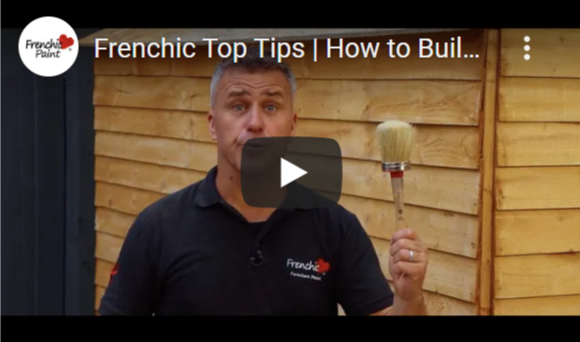How to Paint a Garden Shed (Plus Building & Preparation)
A garden shed can be both an attractive and functional addition to any garden. If you would like to learn how to build and decorate your own wooden shed from scratch or just paint a shed that's already in your garden, this post has you covered.
Read on to discover our top Frenchic tips for creating a pretty and practical shed that will provide the perfect place to store all of your garden equipment. Let's get started!
New sheds - location, location, location!
If you have purchased a brand-new flat-pack garden shed like the one in our video, the most important thing you need to sort out first is where you would like to position it in your outdoor space.
A garden shed needs a sturdy, dry base. If placing it on grass, consider adding concrete slabs or blocks to prevent moisture from seeping in.
Remember, if you place it too close to your garden fence, it can make it difficult or even impossible to paint your shed on one or more sides.
As Craig planned to have his outdoor shed on his driveway, he was able to prepare a movable base on a frame, with castors which allow for easy movement.
Building your wooden shed step by step
- Once your base is prepared, you can begin screwing the panels of the shed into place. Ask a friend or family member to help you, as this is definitely a two-person job!
- Start with the back panel and screw it into the base, then position one of the side panels in place against it and screw it to the back panel. Once this is done, you can then add additional screws to fix the side panel to the base. Do the same for the other side.
- The next task is to add the front panel. With the help of your assistant, hold it in place and make sure that it's level with the sides. Once you are happy with it, you can screw it to both side panels and to the base.
- Drill pilot holes before inserting screws to prevent the wood from splitting. It will also make it easier to insert the screws.
- Now that the frame of your shed is in place, it's time to add the roof! Before you do this, it is recommended that you line the tops of the frame with a multi-use adhesive, to help the roof stay in place when you put it on. Then all you need to do is carefully place the roof into position and screw it to the frame. Your shed construction is almost complete, but Craig advises you not to attach the door or trims at this point. Now it’s time for the preparation…
Prepping your wooden garden shed for a perfect finish
New sheds
The very first thing to do when preparing your shed is to give all the exterior surfaces (not forgetting your set-aside trims and door) a thorough sanding to remove any very rough patches. This will help your paint apply more easily to the bare wood.
Start off with lower-grade sandpaper, and then increase to a higher grade as you go along to create a smoother, more even surface that will allow for good adhesion from the paint.
Existing sheds
Of course, the steps are a little different if you want to paint a shed that's not brand new. Firstly, you'll need to make sure you're dealing with healthy timber. Shed paint can give your shed a lease of new life, but not if it's begun to decay and rot.
All good? It's time to clean your wooden shed ready for painting. A pressure washer is a handy tool for this, as it will get rid of dirt, debris and flaking paint. Make sure the shed is fully dry before painting. You can also use a stiff brush, like a wire brush, if you don't have a jet washer available.
Trim back any overgrown plants to make painting easier. Finally, you should also check for any holes or noticeable imperfections and cover them with wood filler. Once it's completely dry, you can sand it down – it will be practically unnoticeable after some good-quality paint.
You can then follow the steps you would for a new shed when it comes to sanding. Use a sanding block, sandpaper or power sander to abrade the wood. This will ensure any old paint is removed and get the wood ready for new paint.
Applying your paint
Now that preparation is complete, it's time to paint a shed! Before you start, always make sure the timber is completely dry and the weather forecast is fine and dry for the next few days. The British weather can be very changeable, and you don't want an unexpected downpour to affect the curing of your shed paint.
Additionally, you should prepare the area with dust sheets to avoid paint staining your flags, decking or other nearby surfaces. Masking tape can also be used around windows or window frames, if your shed has them. You can cut in if you feel confident, but masking tape always makes it easier to achieve a professional finish.
Craig is using Swanky Pants (below) and Smudge from the Al Fresco range to paint a shed. There are three different methods you can use to paint your garden shed. We have used all three in our video, so you can see how they work.

1. Paint brush
Craig uses a Frenchic brush to paint the edges and corners of the shed. The set-aside trims are most easily painted with a brush – paint all sides to ensure good weatherproofing! For the door, don’t forget the edges! Craig chose to use a contrasting colour for these parts of the shed, to make them stand out in a stylish statement.
Brushing is ideal for any small areas, but you can paint your entire shed using a brush if you so choose. Use light, even brush strokes following the same direction of the wood's grain. End grains on trims can be tricky as they seem to soak up endless paint. This is inevitable, but a good sanding will reduce this effect.
2. Radiator roller
Once the edges and corners are done, you can choose to move on to a small fluffy, radiator roller (foam versions are not so efficient for painting timber). This method is just as easy as using a paint brush, but allows you to cover a greater surface area quicker. To get started, simply pour your paint into a tray and coat your trusty roller. Apply the paint evenly over remaining areas of the shed.
3. Hand-held paint sprayer
The third method you can use is a hand-held paint sprayer, which makes it much quicker and easier to paint large areas.
If you use this tool, you must dilute the paint first, particularly if you are using a high-quality paint like those we create at Frenchic. To dilute, add 10-15% water to the reservoir of the spray and then gently pour in your paint. Stir it all together so the water and paint are thoroughly combined. Screw the lid on tightly, click and connect the pieces of the spray into place – and you're ready to go!
When using a paint spray, move evenly from side to side of the surface you are painting, holding the nozzle between 50 to 100mm from the surface. Craig applies two thin layers consecutively – the first from side to side, the second up and down, to form a single coat with good coverage. He then leaves this coat to dry. Further coats, applied in this way, will be needed.
4. Good coverage
Making sure you have sufficient coverage is particularly important for exterior projects like sheds. Always refer to the instructions on the tin to make sure you apply enough coats to ensure the paint can do its job properly and protect the wood!
Additionally, each coat of paint should be the right thickness. Again, the tin should give you the approximate coverage, which tells you whether you're using too much or too little. Never try to paint your shed in one coat, unless this is recommended on the tin.
Bare timber is porous, so it may absorb much of the first coat. The second coat will be easier to apply but if the finish still looks patchy, you might need a third coat. Before applying each new coat, make sure you follow the guidance for drying times.
If you have used a sprayer, and thinned the paint, you will certainly need an extra layer or two to ensure you have good coverage.
The finishing touches!
Once the shed, doors and trim have all dried, it's time to fix the doors and trim into place. With the help of your friend or family member, you can add the hinges to the door frame and screw the doors into place. Make sure that they swing smoothly, and that they are nice and level with the frame.
Next, you can use your multi-use adhesive and apply it to the shed joints where the trims will sit and also to the back of the trims themselves before fitting them into place. Add some screws for extra strength and durability.
Last but not least, it's time to use the adhesive and screws to fix felt onto your roof to provide extra protection from the elements. Once it is fixed on, tuck the edges under and clamp them into place until the adhesive is dry. And now you're done, and your gorgeous new garden shed is complete!
How to avoid flaking paint
Flaking paint is a common sight on older sheds, and you're probably wondering how to avoid this happening when you paint a shed. Thankfully, there are steps you can take to avoid the paint flaking off after a few months or years.
Firstly, it's important to prepare your shed before painting it. As mentioned above, you need to remove all dirt and debris, which allows your shed paint to properly adhere.
The weather is another vital factor. Rain can impair paint adhesion for obvious reasons. However, direct sunlight or excessive heat can also cause your paint to dry too quickly, while cold temperatures can slow down the curing process too much.
Lastly, selecting the right shed paint is key. You should only paint your shed with a product that's water-resistant and UV-resistant to protect it from the elements. This will avoid the rain and sunlight degrading your shed paint over time, which is another cause of flaking and ultimately shortens your paint's life expectancy!
Choosing the ideal paint for your garden shed
We hope our video and expert tips have helped you build, prep, and paint your garden shed with confidence.
When it comes to choosing what paint to use on your beautiful new shed, why not try something from our Frenchic Al Fresco range. Durable, weatherproof, and environmentally friendly, these luscious paints are the perfect choice for any outdoor building – including your super shed!
With 26 colours plus some limited-edition paints, you can paint your shed in whichever colour you like. The Al Fresco range adheres to both wood and uPVC, so you can paint window frames too. Paint them the same colour as the wood or choose a different colour for a bit of contrast.








